Which measurement microphone should I use with iPhone, iPad, or Mac?
When measuring and analyzing sound with SignalScope or SoundMeter, it is generally best to work with an external microphone to obtain the best results (see the study by Kardous and Shaw). So, I am often asked, “Which mic do you recommend?” The short answer is that you can connect just about any kind of microphone you want to your iPhone, iPad, or Mac through a suitable USB audio interface. The means that choosing a mic must be done with your own specific needs in mind. The suggestions below offer an answer to this question which addresses various needs and budgets. This is not intended to be an exhaustive list, but it is intended to give you an idea of what’s possible when selecting an external measurement microphone (or at least to make it easier to find something that fits your immediate needs).

Headset Microphones
Headset microphones are, by far, the most portable of external measurement microphones to use with your iPhone, iPad, or Mac.
MicW i437L

- Connection Type: Lightning
- Power: Lightning Bus Power
- Affordability: <$200
- Compatibility:
- iPhone: Yes
- iPad: Yes (only iPad models with a Lightning connector)
- Mac: No
- Features:
- According to manufacturer, satisfies relevant requirements for sound level meters that qualify as ANSI Type 2 (see ANSI S1.4 standard)
- Fits a standard 1/4-inch adapter for an acoustic calibrator
- Where to Buy:
MicW i436

- Connection Type: Headset Jack (TRRS 3.5mm mini plug)
- Power: Headset Mic Bias Voltage
- Affordability: <$200
- Compatibility:
- iPhone: Yes (may require Lightning to headset adapter)
- iPad: Yes (may require Lightning or USB-C headset adapter)
- Mac: Yes (may require USB-C headset adapter)
- Features:
- According to manufacturer, satisfies relevant requirements for sound level meters that qualify as ANSI Type 2 (see ANSI S1.4 standard)
- Fits a standard 1/4-inch adapter for an acoustic calibrator
- You can connect 2 i436 microphones, simultaneously, to your iPhone, iPad, or Mac with the RØDE AI-Micro USB-C audio interface for an extremely portable 2-channel measurement setup. The AI-Micro even comes with all the adapter cables you need (including a USB-C to Lightning cable for your iPhone or iPad).
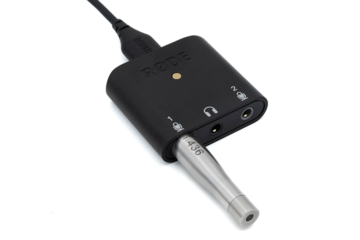
- Where to Buy:
USB Microphones
USB audio devices that conform to the USB Audio Class specification can be used with Apple devices without the need to install any additional drivers. This means they can be used with iPhone and iPad, as well as the Mac.
Dayton UMM-6

- Connection Type: USB
- Power: USB Bus Power
- Affordability: ~$100
- Compatibility:
- iPhone: Yes (requires Apple Lightning to USB 3 Camera Adapter)
- iPad: Yes (requires Apple Lightning to USB 3 Camera Adapter for iPad models with Lightning connector)
- Mac: Yes
- Features:
- Factory-supplied sensitivity data can be automatically loaded into SignalScope or SoundMeter, just by entering the serial number printed on the side of the mic.
- Can be used with a 1/2-inch acoustic calibrator with the Earthworks calibrator adapter for M-series microphones.
- Where to Buy:
miniDSP UMIK-2

- Connection Type: USB
- Power: USB Bus Power
- Affordability: ~$200
- Compatibility:
- iPhone: Yes (requires Apple Lightning to USB 3 Camera Adapter; also requires external power)
- iPad: Yes (requires Apple Lightning to USB 3 Camera Adapter for iPad models with Lightning connector)
- Mac: Yes
- Features:
- Factory-supplied sensitivity data can be automatically loaded into SignalScope or SoundMeter, just by entering the serial number printed on the side of the mic.
- 1/2-inch mic capsule for lower noise floor
- Fits standard 1/2-inch acoustic calibrator
- Selectable sample rates as high as 192 kHz
- Where to Buy:
Lab-grade Microphones
Other measurement microphones connect to your device via a separate USB audio interface. These microphones also require their own form of power. Two common forms of powering microphones are phantom power (commonly found in pro audio hardware) and constant current power (common in dedicated measurement systems for sound and vibration). Constant current power is often identified by different microphone manufacturers as ICP®, CCP, or IEPE. Two example configurations are listed below.
Constant Current Power
The Modal Shop’s Model 485B39 Digital ICP-USB Signal Conditioner
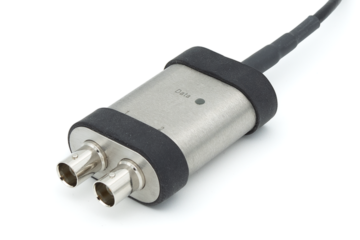
- Connection Type: USB
- Power: USB Bus Power
- Affordability: ~$1,000
- Compatibility:
- iPhone: Yes (requires Apple Lightning to USB 3 Camera Adapter)
- iPad: Yes (requires Apple Lightning to USB 3 Camera Adapter for iPad models with Lightning connector)
- Mac: Yes
- Features:
- Supports using 2 microphones, simultaneously
- Supports standard ICP sensors (e.g microphones, accelerometers, etc)
- Low-power operation with iPhone (no additional power supply necessary)
- Small and very portable
- Where to Buy:
PCB 378B02 1/2″ ICP Free-field Measurement Microphone

- Connection Type: Coaxial BNC
- Power: Constant Current Power (ICP)
- Affordability: ~$1,200
- Compatibility:
- Connects to ICP-compatible input channels on hardware designed for acoustic testing, such as the 485B39
- Features:
- Satisfies relevant requirements for sound level meters that qualify as IEC 61672 Class 1
- Frequency response +/- 2 dB down to 3.75 Hz
- 1/2-inch mic capsule for lower noise floor
- Fits standard 1/2-inch acoustic calibrator
- Where to Buy:
Phantom Power
CEntrance MixerFace USB Audio Interface
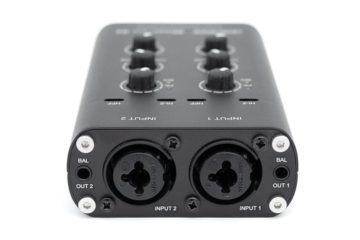
- Connection Type: USB
- Power: Internal Battery Power
- Affordability: ~$500
- Compatibility:
- iPhone: Yes (requires Apple Lightning to USB 3 Camera Adapter)
- iPad: Yes (requires Apple Lightning to USB 3 Camera Adapter for iPad models with Lightning connector)
- Mac: Yes
- Features:
- Supplies 48V phantom power for microphones (phantom power can be switched off)
- Supports using 2 microphones, simultaneously
- Selectable sample rates as high as 192 kHz
- Internal battery for portable operation with iPhone
- Where to Buy:
Earthworks M30 Phantom-powered Measurement Microphone

- Connection Type: 3-pin XLR
- Power: Phantom Power
- Affordability: ~$700
- Compatibility:
- Connects to any audio interface hardware with standard XLR microphone inputs and phantom power
- Features:
- Wide operating bandwidth (3 Hz to 30 kHz)
- According to manufacturer, satisfies relevant requirements for sound level meters that qualify as ANSI Type 1 (see ANSI S1.4 standard)
- Can be used with a 1/2-inch acoustic calibrator with the Earthworks calibrator adapter for M-series microphones
- Where to Buy:
High-bandwidth, High SPL
Special considerations need to be made when you need to measure extreme acoustic phenomena, such as frequencies above 20 kHz or sound levels above 140 dB SPL.
Measuring high frequencies requires an interface that supports higher sampling rates, as well as analog bandwidth to match. The MixerFace, mentioned above, supports sample rates as high as 192 kHz, which would suggest a maximum theoretical bandwidth approaching 96 kHz. However, in my testing I have found that its analog circuitry supports measurements up to about 40 kHz (with a frequency response drop of around 5 dB by the time it gets that high). Of course, any microphone and preamplifier (preamp) you use also need to accommodate your high frequency needs.
When high SPL’s are the goal, then the voltage sensitivity of the measurement mic as well as the maximum voltage of both the mic preamp and the USB interface must be taken into account. As an example, consider PCB’s 377A12 1/4″ microphone capsule, which has a nominal sensitivity of 0.25 mV/Pa and an advertised max sound level (with 3% distortion) of 182 dB and maximum peak sound level of over 194 dB re 20µPa. If 182 dB SPL rms is applied to a mic with a sensitivity of 0.25 mV/Pa, the mic will yield a voltage of about 6.3 V, rms. If the sound is purely sinusoidal (a single frequency), the peak voltage would be about 3 dB higher, or about 8.9 Volts, peak. PCB’s compatible 1/4″ preamps support up to 8 Volts, which would prevent you from measuring such high sound levels. If the sound were more complex, the peak-to-rms ratio would be higher and the maximum measurable rms sound level would then be lower, still. However, PCB’s phantom-powered mic preamp, the 426A14, which can be used with the 377A12 mic capsule, increases the available voltage to 10 Volts, which may be important to your specific application.
The RME ADI-2 Pro FS R USB Audio Interface, listed below, is the best solution I have found for high frequency, high SPL acoustic measurements with your iPhone, iPad, or Mac. It supports sample rates up to 768 kHz (and analog input circuitry to match) and input voltages up to +24 dBu, or 12.283 Volts. Be aware, however, that an external phantom power supply is required, since the ADI-2 Pro does not supply phantom power. Also, the ADI-2 is not especially portable, but it is possible to pair it with a 12-Volt battery and take the whole setup with you. Note that SignalScope X does, in fact, support 768 kHz sampling on iPhone, iPad, and Mac.
RME ADI-2 Pro FS R Reference USB Audio Interface
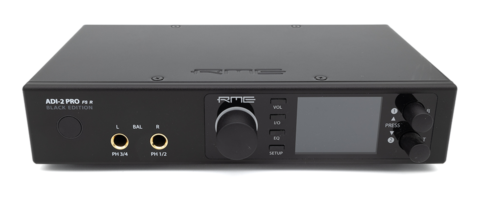
- Connection Type: USB
- Power: External 12V (>1.5A) DC power supply or 12V battery
- Affordability: ~$2,000
- Compatibility:
- iPhone: Yes (requires Apple Lightning to USB 3 Camera Adapter)
- iPad: Yes (requires Apple Lightning to USB 3 Camera Adapter for iPad models with Lightning connector)
- Mac: Yes
- Features:
- High bandwidth, with selectable sample rates up to 768 kHz
- High input levels (up to 12.28 Volts peak input for high SPL measurements with a suitable low-sensitivity microphone)
- Supports using 2 microphones, simultaneously
- Where to Buy:
PCB 426A14 Phantom Powered Microphone Preamp

- Connection Type: 3-pin XLR
- Power: Phantom Power
- Affordability: ~$500-$1,500
- Compatibility:
- Connects to any audio interface hardware with standard XLR microphone inputs and phantom power
- Features:
- Compatible with many USB Audio interface devices
- Wide bandwidth (11 Hz to 100 kHz)
- High input levels (up to 10 Volts peak input for high SPL measurements with a suitable low-sensitivity microphone)
- Where to Buy:
PCB 377C01 1/4″ Microphone Capsule

- Connection Type: Threaded connection to preamp
- Power: Supplied by preamp
- Affordability: ~$1,000-$1,500
- Features:
- Wide bandwidth (3 Hz to 100 kHz)
- Fits a standard 1/4-inch adapter for an acoustic calibrator
- Satisfies relevant requirements for sound level meters that qualify as IEC 61672 Class 1
- Where to Buy:
PCB 377A12 1/4″ Microphone Capsule

- Connection Type: Threaded connection to preamp
- Power: Supplied by preamp
- Affordability: ~$1,000
- Features:
- Low acoustic sensitivity for high SPL measurements
- Fits a standard 1/4-inch adapter for an acoustic calibrator
- Satisfies relevant requirements for sound level meters that qualify as IEC 61672 Class 1
- Where to Buy:
Mackie M48 Phantom Power Supply
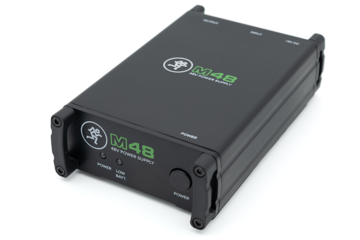
- Connection Type: 3-pin XLR
- Power: Supplied by 9V battery or external 9V DC power supply
- Affordability: ~$60
- Features:
- Supports voltage and bandwidth requirements of the microphones mentioned above
- Can be powered from a 9V battery or common 9V DC power adapter
- Enables a phantom-powered measurement microphone to be used with an audio interface, such as the ADI-2 Pro, that does not supply its own phantom power.
- Where to Buy:
Calibrators
All microphones presented, here, will fit a standard 1/2-inch microphone calibrator (adapters are required for the smaller mics). Calibration with a dedicated calibrator is the recommended method for calibrating your microphone with SignalScope or SoundMeter. For additional guidance, see “How do I calibrate my microphone with SignalScope or SoundMeter?“
Reed Instruments R8090 Microphone Calibrator
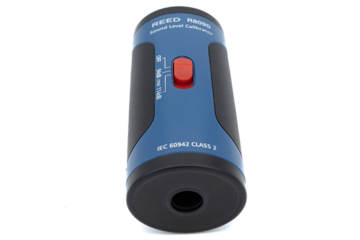
- Microphone Size: 1/2-inch
- Accuracy: +/- 0.5 dB
- Affordability: ~$200-$400
- Features:
- Switchable calibration amplitude: 94 or 114 dB at 1 kHz
- Fits standard 1/2-inch measurement microphones
- Where to Buy:
Larson Davis CAL200 Microphone Calibrator
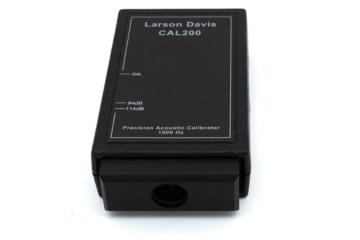
- Microphone Size: 1/2-inch
- Accuracy: +/- 0.2 dB
- Affordability: ~$600
- Features:
- Switchable calibration amplitude: 94 or 114 dB at 1 kHz
- Fits standard 1/2-inch measurement microphones
- Conforms to IEC 60942, Class 1
- Where to Buy:
Accessories
- Apple Lightning to USB 3 Camera Adapter
- Earthworks Microphone Calibrator Adapter for M-series Microphones (also works with Dayton UMM-6)
- 1/4-inch Microphone Calibrator Adapter
- USB C Hub
- You may need a USB C hub or adapter to connect your USB Audio interface or microphone to an iPad or Mac with USB C ports.
- Buy from Amazon
Other Options
This list of measurement microphone suggestions is provided for the convenience of SignalScope and SoundMeter users. There are many other microphones available from various manufacturers (including those already mentioned) that may be better suited to various needs, budgets, or circumstances. Here is a short list of measurement microphone manufacturers:
- ACO Pacific
- Audix
- Brüel & Kjær
- Dayton Audio
- GRAS Sound & Vibration
- miniDSP Ltd
- PCB Piezotronics, Inc.
If you would like to learn more about measuring sound with mobile devices, take a look at the article I wrote for Acoustics Today Magazine: “Acoustical Measurements with Smartphones: Possibilities and Limitations“
Note: Costs given above are only rough estimates and are subject to change without notice. Listed product details are not guaranteed and are also subject to change without notice.
PCB® and ICP® are registered trademarks of PCB Piezotronics, Inc. in the United States.
Faber Acoustical, LLC is a participant in the Amazon Services LLC Associates Program, an affiliate advertising program designed to provide a means for sites to earn advertising fees by advertising and linking to amazon.com.
Faber Acoustical, LLC also participates in the B&H Affiliate Program.





Pingback: How do I calibrate my microphone with SignalScope or SoundMeter? – Faber Acoustical Blog
Pingback: SignalScope and SoundMeter now support Dayton iMM-6C microphone – Faber Acoustical Blog